| Click on image to start animated
sequence. |
Click on  to view QuickTime
movie. to view QuickTime
movie. | |
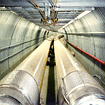 |
INTRODUCTIONThe Relativistic Heavy Ion Collider at
Brookhaven National Laboratory is the world's largest
superconducting accelerator for producing high energy collisions of
"heavy ions", the atomic nuclei of heavy elements such as gold. Each
head-on collision will produce temperatures and pressures that have
not existed since the Big Bang created the universe. Under such
conditions neutrons and protons are expected to disintegrate into
the most elementary building blocks of matter in nature, called
quarks, and the quanta of energy which transmit the forces that
normally bind them together, called gluons.
This animated simulation shows the collision of two gold nuclei
and the predicted results for the brief time following the
collision. The times indicated in the animation are in units of a
fermi divided by the speed of light, about 3x10**(-24) seconds. This
is about the time needed for light to traverse the nucleus of a
hydrogen atom. Time zero corresponds to the instant of collision of
the gold nuclei.
The simulation uses the parton cascade model of Klaus
Kinder-Geiger, which is based on the theory of perturbative Quantum
Chromodynamics. |
|
 |
PART ONE
In the RHIC collider experiment
two gold nuclei move toward each other at approximately the speed of
light. Relativistic contraction causes the gold nuclei to appear
flattened. At these ultra high energies the two gold nuclei see each
other as consisting of quarks and gluons, not protons and neutrons.
In this animation quarks are colored white and gluons are colored
green. At time zero the quarks and gluons begin to scatter off each
other forming a quark gluon plasma. |

3.0 MB |
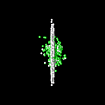 |
PART TWO
The pure quark gluon plasma phase
lasts only for the time it takes light to travel 7/10th of a fermi,
which is the size of a proton at rest. Quarks and gluons can appear
to move faster than light because of the uncertainty principle. The
slower moving the particle, the more uncertain its position, thus it
appears to move faster. |

0.5 MB |
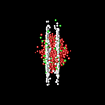 |
PART THREE
The slower moving quarks and
gluons begin to coalesce into excited short-lived states called
prehadronic clusters. These clusters decay into hadrons. Here, the
prehadronic clusters are colored red and their size is proportional
to their mass. After the gold nuclei have separated by 3 fermis,
quark-gluon scattering has stopped. Now the prehadronic clusters are
beginning to scatter off each other. |

0.7 MB |
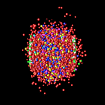 |
PART FOUR
The prehadronic clusters continue
to scatter. Some clusters decay into hadrons. In the animation these
hadrons are colored blue for pions, yellow for kaons, and cyan for
protons and neutrons. All other excited hadrons are shown as
magenta. |

3.0 MB |
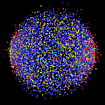 |
PART FIVE
The fast moving prehadronic
clusters, which are becoming confined to regions moving to the right
and left, continue to scatter off each other. The slower clusters
have decayed into hadrons in the middle region. This delay of the
decay for the fast moving clusters is due to a relativistic time
dilation. The distance, in fermis, between the fast moving regions
is twice the time shown. At this scale, about 1/1000th the size of
atoms, we have filled the screen. For further viewing, we have to
pull back at the speed of light in order to keep the particles
contained in our field of view. |

7.7 MB |
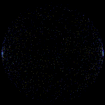 |
PART SIX
As we pull back, the sizes of the
particles appear to become smaller. We see that the density of
particles is becoming less. The fast moving prehadronic clusters
finally decay into hadrons. The greatest density of particles
remains in the regions moving to the right and left. In this final
view, the particles still occupy a space much smaller than the size
of an atom. This collection of particles will have to expand more
than 10 billion times before we will be able to measure them in
particle detectors at the RHIC collider facilities. |

12.7 MB |
 |
PART SEVEN
Now we will play the entire
animation without interruption. |

27.4 MB |
| |
CREDITS
Au + Au Simulation
Data
Klaus
Kinder-Geiger
Ronald Longacre
Au + Au Visualization
Ballard
Andrews
Michael
McGuigan
Gordon Smith
|
|